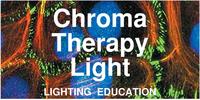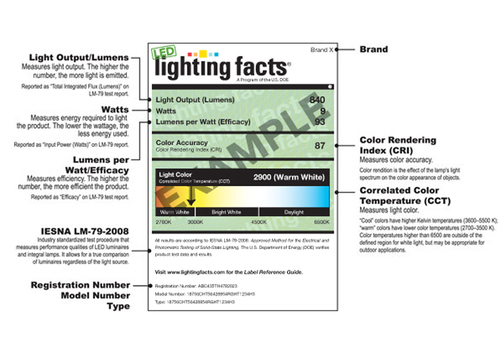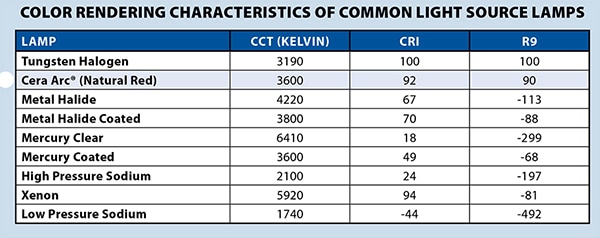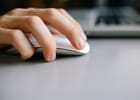CRI - Learning Objectives
What is CRI?The term CRI stands for Color Rendering Index measures the ability of a light source to render a standardized sample of 12 colors and is calibrated against how colors appear against natural daylight. The CRI number, references to the measuring scale of 100 being daylight, indicates how closely the light source matches daylight. Many jurisdictions and museums require a CRI over 90. Many commercial grade light sources only make it to 80, because with higher CRI, the Lumens per Watt decreases.
The challenge is that these 12 colors do not give an accurate view of the range of colors across the spectrum. The CCT, Color Temperature is another different measurement expressed in degrees Kelvin. This metric shows if a light source appears warmer or cooler. Recently, a more complex color rendering measuring system TM-30 has been developed by the IES. R9 Color Rendering Test Colors
Color Rendering Index (CRI) indicates the ability of a light source to render color accurately. The problem is that the original 8 muddy colors, and the addition of 4 additonal colors are not enough to judge a light source's ability to accurately render all colors.
Sunlight and Halogen Incandescent lighting score 100 serving as the basis for color comparisons for values of CRI. Regulations in California (Title 24) require 90 CRI or higher in Residential applications. Commercial projects often use light sources with 80 CRI or as low as 70. As LED light source technology advances, the CRI is improving; however, it is important to learn about the color rendering and limitations of a particular light source before specifying or purchasing, since most light sources cannot be returned, because the wholesaler or retailer cannot tell how many hours the lamp (light source) has been used. 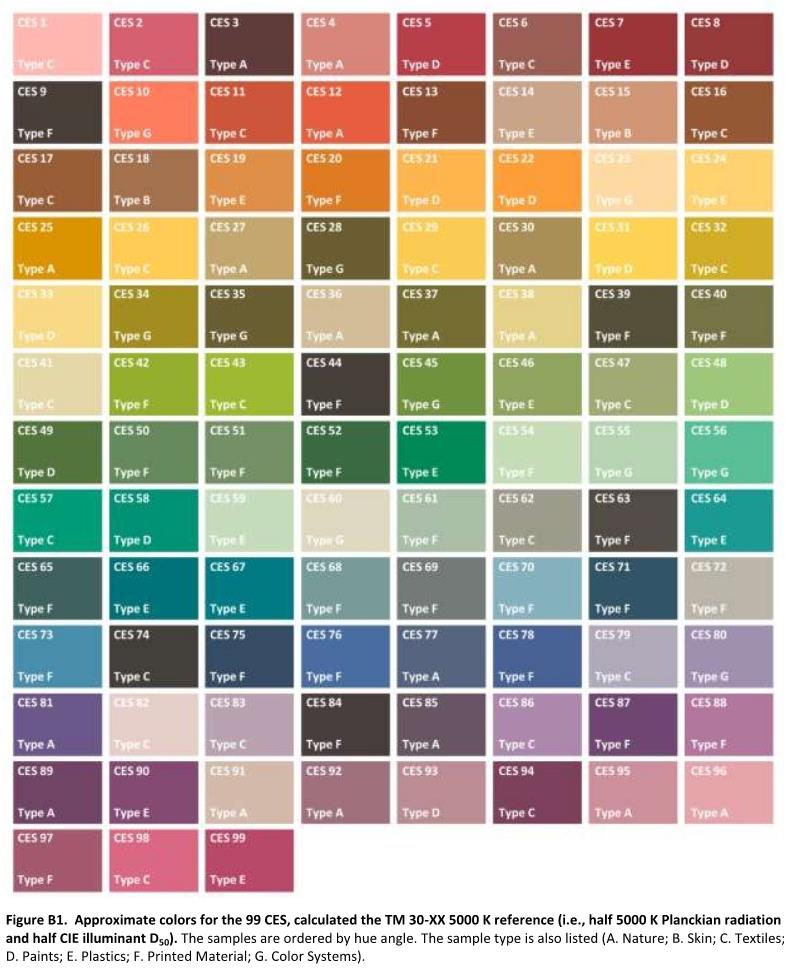
TM-30 Color Type Key:
A-Nature B-Skin C-Textiles D-Paints E-Plastics F-Printed Materials G-Color Systems. TM-29 is a more detailed analysis of color rendering for a light source. |
CRI is included on the lighting facts data printed on packaging to inform consumers.
DOE - Department of Energy
|
- Home
-
- CHROMA Topics
- Color Spectrum - Light is Energy
- Color in Light
- Color in Nature
- Color in Paint
- Why does paint fade?
- Color Names & Meanings
- Color Phenomena
- Color Perception is Individual
- Color In Fashion
- Color for your home
- Color in Space
- Color Blindness
- Color Blind Interview
- Synesthesia
- Synesthete Deborah Borrowdale-Cox
- Synesthete Stephen Orr, BH&G Editor
-
- Circadian & THERAPY Topics
- Circadian Explained
- Circadian Ganglion Cells
- Circadian Melatonin
- Circadian Animals
- Circadian Research
- Autism & Lighting for the Spectrum
- Blue Light Dimming Apps
- Red Night Lights
- Vitamin D & Light
- SAD - Seasonal Affective Disorder
- Alzheimers and Light Therapy
- Photosensitivity - Light Sensitive Drugs
- Red Light Therapy
- Sleep & Lighting
- Dreams and Second Sleep
- NASA - Lighting in Space & Undersea
- Jet Lag
- Sunglasses
- Chakras
- Crystals, Minerals, & Gemstones
-
- LIGHTing Design Topics
- UV Germicidal Disinfection Light
- LED Lighting Facts Card
- CRI - Color Rendering Index
- LED TM-30
- LED Kelvin Color
- LED LPW
- LED Flicker
- LED Glare
- OLED - Organic LED
- Human Centric Lighting
- Lighting with Daylighting
- Lighting for Healthy Buildings & Zero Net Energy
- Lighting for Healthcare
- Lighting for Horticulture
- Lighting for Hospitality & LED Retrofits
- Lighting for Museums
- Lighting for Seniors & Low Vision
- Lighting Design Tips & Codes
- Parking Lot Lighting
- Solar Lighting for Humanity & World Health
- Davis Insectary Garden
- Santa Barbara Mesa Insectary Garden
- Home
-
- CHROMA Topics
- Color Spectrum - Light is Energy
- Color in Light
- Color in Nature
- Color in Paint
- Why does paint fade?
- Color Names & Meanings
- Color Phenomena
- Color Perception is Individual
- Color In Fashion
- Color for your home
- Color in Space
- Color Blindness
- Color Blind Interview
- Synesthesia
- Synesthete Deborah Borrowdale-Cox
- Synesthete Stephen Orr, BH&G Editor
-
- Circadian & THERAPY Topics
- Circadian Explained
- Circadian Ganglion Cells
- Circadian Melatonin
- Circadian Animals
- Circadian Research
- Autism & Lighting for the Spectrum
- Blue Light Dimming Apps
- Red Night Lights
- Vitamin D & Light
- SAD - Seasonal Affective Disorder
- Alzheimers and Light Therapy
- Photosensitivity - Light Sensitive Drugs
- Red Light Therapy
- Sleep & Lighting
- Dreams and Second Sleep
- NASA - Lighting in Space & Undersea
- Jet Lag
- Sunglasses
- Chakras
- Crystals, Minerals, & Gemstones
-
- LIGHTing Design Topics
- UV Germicidal Disinfection Light
- LED Lighting Facts Card
- CRI - Color Rendering Index
- LED TM-30
- LED Kelvin Color
- LED LPW
- LED Flicker
- LED Glare
- OLED - Organic LED
- Human Centric Lighting
- Lighting with Daylighting
- Lighting for Healthy Buildings & Zero Net Energy
- Lighting for Healthcare
- Lighting for Horticulture
- Lighting for Hospitality & LED Retrofits
- Lighting for Museums
- Lighting for Seniors & Low Vision
- Lighting Design Tips & Codes
- Parking Lot Lighting
- Solar Lighting for Humanity & World Health
- Davis Insectary Garden
- Santa Barbara Mesa Insectary Garden
